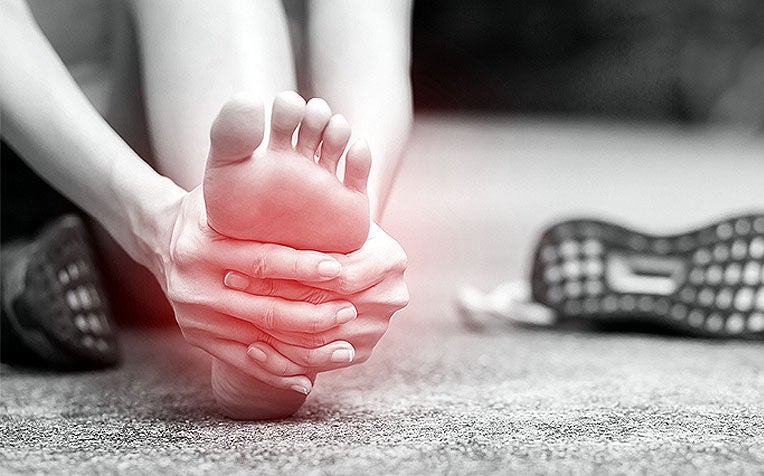
Plantar Fasciitis the most common form of heel pain, can affect one or both feet.
Plantar fasciitis (pronounced fash-ee-eye-tus) is the most common cause of heel pain. It is caused by inflammation of the plantar fascia, or the band of muscle located under the foot.
Pain is usually worst first thing in the morning. After a few minutes it eases as the foot gets warmed up, but it can worsen during the day with prolonged walking.

"This condition (plantar fasciitis) is most commonly seen in people who make poor choices of footwear, wearing thin soles or footwear which is not supportive enough, or those who suddenly go back to strenuous activity after a long period of rest. It can also occur in people who have a short calf musculature or a poor ankle range of motion," explains the Department of Podiatry from Singapore General Hospital (SGH), a member of the SingHealth group.
it is not necessary to rush to a doctor immediately if you experience some heel pain. However, if your pain does not clear up after a week of wearing better footwear, then you should see a doctor.
Home remedies for plantar fasciitis
1. Rest but stretch
Avoiding overuse and resting is one key to recovery. However, it is essential to couple this with daily stretching exercises, several times a day.
Calf stretching exercises are great for preventing the plantar fascia from pulling and tightening up. Here are two examples of calf stretching exercises to do daily:
a) Calf stretch with towel
Sit down with your legs stretched out in front of you and place a medium size towel under the ball (top portion) of your foot.
Hold the two ends of the towel in separate hands, pulling the towel gently towards you while keeping your knees straight.
Hold for a minimum of 10-15 seconds and repeat a few times.
b) Calf stretch against the wall
Stand up and place your hand against the wall, keeping one leg in front with your knees bent.
Keep the other leg behind with your knees straight and lunge forward.
Hold for a minimum of 10-15 seconds and repeat a few times.
Other foot stretching exercises you can do include the rolling stretch (placing a round object under the foot and rolling it back and forth) and towel curl (curling a towel with the toes).
2. Wear proper footwear
Be sure to wear proper footwear with a good fit and avoid flat shoes that lack support. For those with plantar fasciitis, it is also recommended to wear good supportive footwear at all times, even at home.
Choosing running shoes or sneakers, something with natural arch support, is a good choice.
3. Ice your feet
A way to do this is to roll your foot over a frozen water bottle for 5 minutes, or hold an ice pack over the bottom of your foot for 15 minutes, three times a day.
Also use the ice treatment after any strenuous activity or extended periods of standing or sitting
4. Wear a splint
It is common to sleep with feet pointed down, which shortens the plantar fascia and achilles tendon. Night splints, which are worn while you sleep, help keep the feet at a 90-degree angle. Thus, instead of shortening the plantar fascia, it provides a good, constant stretch while you sleep. Once your condition improves, you can stop wearing them.
Causes and symptoms of plantar fasciitis
Plantar fasciitis is caused by strain to a muscle under the foot that gives support to the arch, and commonly affects middle-aged men and women. It also tends to affect those with obesity issues and those who engage in prolonged standing.
In plantar fasciitis, the muscle band under the foot may develop small tears and inflammation from recurrent strain, causing pain and swelling in the foot. It can also affect one foot or both feet.
The most common symptom of plantar fasciitis is 'first step pain'. This is the heel pain that is felt when a person with plantar fasciitis feels when he/she gets up from bed in the morning and stands up for the first time, or when a person stands up after sitting for a long period of time.
How is plantar fasciitis treated?
A doctor may advise you to get a diagnostic ultrasound or x-ray after assessing your symptoms and medical history.
Ms Heng adds, "Treatment includes resting, icing and the use of orthotics or foot supports, and anti-inflammation drugs. Doctors may sometimes also give a steroid injection to settle the inflammation. Surgery is a last resort after all other conservative means have been exhausted in chronic cases."
Patients are usually advised to rest for 3-8 weeks, with an average of six weeks, depending on the severity of the injury.
Can I still do sports and other activities?
People suffering from plantar fasciitis should refrain from active sports and other physical activities during periods of acute injury.
Those with chronic heel pain, however, can do light exercises using supportive footwear that has been fitted with insoles or braces.
As a preventive measure, women who favour high heels stretch their calf muscles daily to ensure that their calf muscles are not shortened by prolonged or continuous use of the high heels. Shortening of calf muscles may predispose one to plantar fasciitis.
Plantar fasciitis usually has a very good prognosis as long as the patient complies with the treatment as advised.
Ref. I23 (ed)
Related articles on common foot conditions:
Ankle Arthritis (Ankle Pain): Tips to Manage
Bunions: Common Causes and Treatment
Achilles Pain: Causes, Symptoms and Treatment
Contributed by


















 Get it on Google Play
Get it on Google Play